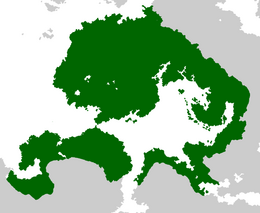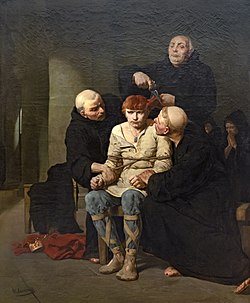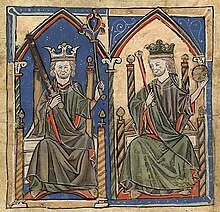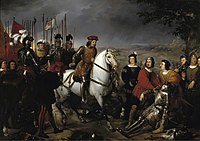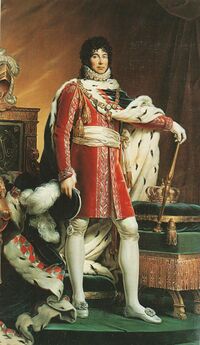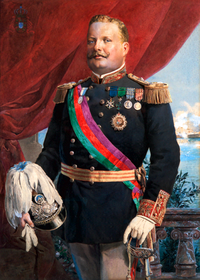Vvarden
The reason given is:
Last edit by: Vvarden (talk · contrib) · Last edited on Mon, 11 May 2020 00:56:21 +0000
This article is incomplete because it is pending further input from participants, or it is a work-in-progress by one author. Please comment on this article's talk page to share your input, comments and questions. Note: To contribute to this article, you may need to seek help from the author(s) of this page. |
Vvardenese Republic ... | |
|---|---|
| Motto: Hoc hic misterium fidei firmiter profitemur "Here is the mystery of faith that we strongly profess" | |
| Anthem: Gaibez á bri verde, Oh bailo au Iogan ("Bound by green hill forts, O hearth of Iogan") | |
| Official languages | Lugonian, Callae |
| Demonym(s) | Vvardenese |
| Government | |
• President | Amaro Piras |
• Prime Minister | Iagu Trudu |
| Establishment | |
• Subjugation of local Veyene and Celtic peoples by the Fiorentine Empire | 50-60 B.C |
• Gautigothic Kingdom established | 523 C.E |
| 851 C.E | |
• Union of Callasia and Lugonia | 1511 C.E |
• Great Searlesian Rising | 1717 C.E |
• Loisine War | 1802 C.E |
| 1895 C.E | |
| 1923 C.E | |
| 1989 C.E | |
| Population | |
• Estimate | 32,000,000 |
• 2018 census | 31,812,420 |
| Currency | Vvardenese Rial (VR) |
| Date format | dd ˘ mm ˘ yyyy |
| Driving side | left |
| Internet TLD | .vvr |
Vvarden, officially called the Vvardenese Federation (Vvardenese: ...), or also known as the ..., is a ... on the continent of Asura located within Aeia. The official languages are Callae and Lugonian, which is spoken by approximately 60 million people worldwide.
Modern humans first arrived in the Vvarden around 35,000 years ago, and developed neolithic cultures. Sifharo-Asuran Foranic cultures, arrived in the region around the 6th or 5th century BCE, along with ancient ... and ... settlements. Vvarden began to be under Fiorentine rule around 180 BCE. Fiorentine rule was centred along the west coast near large iron deposits and trading ports, and Vvarden was not fully conquered until the end of the first century AD. Previous military expeditions to subdue the east Foranic tribes in the mountains, such as those of Marcus Cornelius Gallicanus, and Aelius Magnus, had mostly ended in failure, making the Fiorentines content to hold onto the western half of the country. As such, there was not a lot of expansion of Fiorentine cultural influence further inland for at least some time, forming the beginning of Vvarden's modern day cultural divide. From AD 47, three years after the ascension of Nero, grandnephew of Gaius Claudius Caesar Augustus, the eastern half was slowly conquered, with the Fiorentines settling many colonies, most notably Colonia Victricensis with its large Temple of Nero, the largest of its type in the eastern half of the country. The conquest was finally completed by AD 96, but even then there remained loose pockets of resistance and some rebellions, particularly in the highlands.
At the beginning of the fifth century, the Fiorentine Empire led by Sebastianus abandoned the province in response to the increasing threat faced by eastern Alemannic migrations. These Vvardenese cities, which were told to organise their own defences from resurgent Marric invaders sweeping south, as well as from invading Alemannic groups, began to fragment among tribal lines, becoming separate kingdoms in their own right. Alemannic groups, like those of the Gautigoths and Taifals, invaded and managed to unite a majority of Vvarden by the 7th century under the Amalic Kingdom, but were quickly assimilated into the local Fioreno-Marric population. Over the next few hundred years, the ethnic distinction between the indigenous population and the Alemannic invaders had mostly dissipated; the Gautigoth language consigned to the declining function of a church language at the time of the abolishment of different laws for Allamanic and Vardene peoples in 654. The nobility of the Amalic Kingdom, in particular the Mayors of the Palace, slowly gained power from the monarchy and from one another, turning them into little more than figureheads. Eventually the reign of the Amalic dynasty came to an end when one of the Mayors of the Palace, Vermudo de Lugones, removed the figurehead King Gandolfo, establishing the Kingdom of Lugonia. By the year 1300, most of Vvarden's kingdoms had been united into two entities, the Kingdom of Lugonia, and the Kingdom of ... . These two kingdoms were unified themselves in the Pact of Wernimes-Orobis in 1511, which formed a marriage between Merriano IV of Lugonia and Brigida II of Callasia. Upon their death, the throne passed to their only surviving son, Sarles I, who formed the United Kingdom of Vvarden.
During the 18th and 19th century, Vvarden underwent a number of stresses, such as wars of succession, ethnic strife, clashings between conservative and liberal tendencies, and the decline of its colonial empire. After a political crisis during the Great War, Vvarden became a republic in 1898. This First Republic was unstable, and monarchist sympathies remained strong, resulting in the failed August Coup of 1912. A civil war in 1932 ended with the formation of the anarcho-syndicalist ... People's Federation. This Federation joined the forces of the ... in the Second Great War, resulting in their defeat in the 1940s. In the 1950s, after the destructive Second Great War, there was a political reshuffling in the new Second Republic of Vvarden that led to the elections of social democratic and mostly market liberal presidents such as Joan-Pol Cuba, Francus MacoDaucale, and Mircado Carenotin. Due to political crises in the late 1950s, the Second Republic of Vvarden was reformed into the Vvardenese Republic in 1960 under Ramon Ovalle, creating a presidential system. The 1960s, 1970s and 1980s were marked by unprecedented economic growth, especially under Presidents Larennt Bedia and Brigida Sandias, of which the strong directive role of the state during the 60s and 70s is said to be responsible. Since the 1940s, Vvarden has become a secondary power in Asura both economically and politically.
Vvarden has left a profound cultural and architectural influence across the globe and a legacy of ... million Vvardenese speakers, especially in former colonies and current possessions of Vvarden, from which many Vvardenese-based creoles exist.
Etymology
The origin of the term "Vvarden" is highly debated. Some have stated that it originates in proto-Foranic artodunom, meaning "Bear-Fort", which became corrupted with the Gautigoths into Waradun, which became "Varden". Other scholars of the proto-Foranic origin for Vvarden's name have instead proposed wailodun meaning "Wolf-Fort" as the origin. There are those who believe it has a root in the proto-Alemannic walhaz or "foreigner", wada or "ford", or wardana meaning "protector"; combined with denaraz meaning "palm" or "flat", or even the Foranic "dunom". Others have completely rejected either school, stating it has a Fiorentine or even a pre-Sifharo-Asuran origin.
History
Prehistory
Vvarden was inhabited, first by Homo erectus, then by Homo Glenmorensis. Archaeological findings from cavs in the Cerbantian mountains reveal that Vvarden was populated by hominids at least some 1 million years ago. Modern day humans are believed to have arrived from the east around 36,000 years ago, leaving behind cultural items such as cave paintings like those in ... . Vvarden is believed to have been one of the major refuges for early human populations within Asura during the ice age, and findings show the area was relatively populated and lively. In the Mesolithic period, a native culture developed, that of the ..., and later, with the introduction of the Bronze Age, megaliths and tumuli were constructed. In the Iron Age, the territory came under the cultural influence of the Foranics; the local Foranic peoples, known as the Callaecians, were composed of tribes such as the Luggones, the Pesicos, and others, who populated the entire area with fortified hill-towns.
Fiorentine Vvarden
Vvarden was ultimately completely conquered by the Fiorentines over a period of two hundred years, and managed to continue control of it for another six hundred, bringing Fiorentine influence. This influence had a profound impact on the cultural and linguistic nature of Vvarden. The west became densely populated with Fiorentine speakers, mostly assimilating the native Foranics, unlike the more rustic and sporadically controlled centre and east, controlled by the Callaecians. This enabled the pre-Fiorentine Callaecian language to survive and evolve into the languages of modern Vvarden, albeit not without significant influence. Fiorentine rule was cemented through constructs such as roads, and bindings such as their laws. For most of the Fiorentine period, Vvarden acted as a granary for the empire, exporting olives, wool, gold, iron, lead, and wine across the empire. Agricultural yield boomed thanks to irrigation projects, like aqueducts, which still remain today in many parts of Vvarden. The Fiorentine Emperors ..., ..., ..., Lugonicus, and ... were born in Vvarden, along with the noted philosopher ... . Vvarden converted to Alydianism after missionaries came in around the 2nd century, quickly becoming popular. These Fiorentine and Callaecian influences went on to define much of Vvarden's later laws, languages, and its religions.
Post-Fiorentine Vvarden and the Kingdom of the Gautigoths
Main articles: History of the Gautigothic Kingdom, Syagrii dynasty, and Amaling dynasty
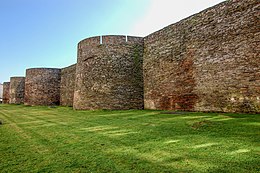
In 399, Gautigothic tribes had entered Vvarden, looking for lands to settle and raid. Although the Fiorentine Empire began to disintegrate in the 4th century, leading to the abandonment of Vvarden by Emperor Sebastianus in 422, many of the successor regimes in Vvarden maintained much of the laws and customs of the collapsed empire. During the fall of the Fiorentine Empire, pirates from Wradhia and Cuirpthe began to raid the coast of Vvarden, and were followed in three centuries by Lhedwinic raiders. Some of the most prominent cities of Fiorentinized coastal Vvarden, having been disconnected from the Fiorentines since the abandonment of the province in 422, formed judicates (judicati) and banded together to resist invaders. Among the most notable of these judicates was Aeminium (near modern Conibria), ruled by the Syagrii family, who continued to style themselves as Dominates of the Fiorentine Empire. The Syagrii family eventually united these judicates, forming a briefly successful post-Fiorentine state in Vvarden. While officially calling themselves the rulers of the Fiorentine Empire, they also called themselves the Dukes of the Lugonians, or Dux Lugoniae, and were elected from candidates in the family by a council of nobles. Up until their conquest at the hands of the Gautigoths in 524, the Dukes of Lugonia are seen as by many as the "the last of the Fiorentines."
Other notable states of post-Fiorentine Vvarden includes part of the Fiorento-Foranic kingdom of ..., which became a source of many legends and stories in the Middle Ages, such as the ... Cycle, based on the legendary King ... . In this time, Callea was in the hands of several Fiorento-Foranic states in what was called the "Old East" or Sé Tusto. These states included Morodon, Temro, Breganto, and Daro. Many of these Post-Fiorentine Callean states labelled themselves as dukes and princes of their dynasties rather than basing themselves off of geographical elements like the Callaecians, and it is in this time that clans such as the Au Verdorci, Au Briagoi, Au Cunocobri, Au Arcadi, and Au Bailai emerge. Many tribes would fight over the title of High King, although only a few succeeded to unite most of these clans.
Most of Vvarden was eventually united by the Amaling dynasty of the Gautigoths in 524 under King Leoverto, creating the Amalic or Gautigothic Kingdom. Leoverto was also the first king to give written laws to the Gautigoths. His successors assumed the role of protectors of the Fiorentine rites of the Alydianist Church, against Foranic Alydianism in the north, and in these devastating wars many of the Amaling kings, such as Leoverto's sons Leodo I and Leodomiro I, were killed. Atanaxildo's descendant, Tedegildo III, who led armies to conquer Foranic lands and pagans in the east, is commonly seen as the last powerful Amaling King. In 820, upon the death of High King Xuntomiro, his lands were divided between his sons Xaudemiro and Xelimiro. Over the next few decades, Gautigothic lands shrank to foreign conquests and rebelling nobles until it was reduced to a rump state in western Vvarden. In 851, the Mayor of the Palace, Vermudo deposed the last member of the Amaling dynasty, Gandolfo Amaling, tonsuring him and exiling him to a monastery, ending over three hundred years of Gautigothic rule. With the support of the remaining nobility and the blessing of the Pontiff of Laterna, Vermudo became the first King of Lugonia (Rex Lugoniae).
Middle Ages
In the east, following the example of Vermudo, the minor landowner Doncado MacoBriago au Carantos, also known as Doncado Dono or Doncado the Brown, was able to seize several towns in the hilly and mountainous area of eastern Vvarden, crowning himself King of Callasia in 852. Doncado was a member of a clan who traced themselves back to a legendary Fiorentine noble by the name of Arcado Dubo who remained in Vvarden and resisted the Gautigoths. Callasia, rather unusually for the time, was an elective monarchy, where the King would be elected from candidates provided by various noble families, a tradition of Lugonia. Around the turn of the 13th century, names from purely Foranic origins like Vedorcu or Daucale or Malcunu became less common among the ruling classes in Callasia, replaced by names that had either Gautigoth or Fiorentine origins like Ricmeru, Alfonsu, Remanu, and Vernandu. The name change reflects the increasingly changing nature of Vvarden entering the Late Medieval Period, as influences from nearby Fiorentine cultures slowly replaced many aspects of traditional Foranic culture. The kings of Callasia and Lugonia and their nobles fought for power and influence in this period. The example of the Fiorentine emperors influenced the political objective of the Crown, while the nobles benefited from the hierarchy of feudalism.
The situation in Vvarden became increasingly complex and divisive by the time of the arrival of the Normaunds in the early 11th century. In 1007, Normaund pilgrims started travelling to Vvarden in order to pay homage at certain holy sites, such as the Temple of St. Landus at Carnu, and the Monastery of St. Dimas on Monte Vindu. Others travelled to Vvarden as mercenaries, such as in the case of the Brai family. The Normaund Brai family so distinguished themselves in service to Lugonia in the War of Brigantia that King Nepoxano gave Robert de Brai the frontier counties of Esarno, Eiras, Brega and Tirtocu in 1012. King Nepoxano had hoped to appease the issue of Normaund immigration into Vvarden by giving them a rural, impoverished, area to settle in. Contrary to his expectations, the Brais were able to rebuild and fortify the area using advanced construction techniques picked up in their time in Mydroll, fortifying the land with many castles.
In addition, their military prowess consolidated their hold in the area, establishing themselves as powerful vassals of King Nepoxano. They were then able to influence Lugonian politics to a large degree. Wiscard and Onfroi de Brai were able to carve themselves a crusader state in the north of Vvarden, the Principality of Cervontes, which paid tribute to Lugonia. Wiscard himself was crowned Prince by the Archbishop of Sant'Eremo, who had feuded with the rulers Lugonia. before many of them were murdered and banished in the Massacre of St Senoch's Day in 1028. The De Brais continued to be independent from Lugonia as the Principality of Cervontes until 1158. The Normaunds contributed to the increasing cultural diversity within Vvarden, bringing with them certain styles of architecture, certain words, names, as well as the ... language. The ... language is descended from the Old Midrasian language that Normaund pilgrims, missionaries, and leaders spread when they settled the north of Vvarden, and has survived albeit being considerably influenced by local Callaecian dialects. More recently a study of the ... language identified a large percentage of words having pre-Normaund words, and more interestingly, these words seem to belong to an unknown language similar to Wradhian that was heavily influenced by Fiorentine just as Callaecian was. These words most likely come from the inhabitants of the region before the arrival of Normaund pilgrims and crusaders, who either were massacred or were assimilated.
In the 9th century, the rise of the cult of the Apostle ... in ... gave Callasia and Lugonia a particular symbolic importance among Alydianists, an importance it would hold throughout the Middle Ages. As time went on, ... became a major pilgrim destination and the Way of ... a major pilgrim road passing through Callasia and Lugonia, became a route for the propagation of Fiorenesque art and the words and music of troubadours and court poets. This in turn led to the Lugonian language becoming the language of preference for poetry and songs in southwestern Asura, earning it the nickname, "The language of troubadours". The Way of ... helped lead to the beginning of standardising the dialects spoken between Lugonia and Callasia, encouraged by monks inhabiting the monasteries on the Way, something which helped spark the beginnings of Vvardenese nationalism. Holy orders sprung up in Lugonia such as the Order of ..., and the Knights of Saint Elmo, taking part in many of the Crusades. Despite their mixed success, they remained influential in the politics of Vvarden, and many Vvardenese towns trace their origins to nearby fortifications formerly owned by these holy orders.
These two kingdoms were unified in the Pact of Wernimes-Orobis in 1511, which formed a marriage between Merriano IV of Lugonia and Brigida II of Callasia. Shortly after, in 1511, Lugonia and Callasia were united in the Pact of Wernimes-Orobis, and their son Searles I combined the two kingdoms into a United Kingdom of ... .
Vvardenese Empire
Vvarden engaged in the colonization of the New World, as well as establishing trade posts in Arabekh and Majula in the 15th and 16th century. Despite the successes of their colonial endeavours, and the wealth brought in from trading in goods rare to Asurans like spices, Vvarden slowly became more and more focused on Asuran affairs, with much of the colonial profits being used to pay for wars Vvarden found itself dragged into. By the time that Vvarden had stabilised its position in Asura, they were being out-competed on the colonial front.
Liberalism and Searlesianists
The first ... king of Iberunia ..., claimed both his right to the throne and authority came from God, or divine right. This concept in many ways provided a justification for increasing centralisation, which continued until the end of the dynasty. This centralisation in many ways brought the monarchy into conflict with much of the aristocracy, many of which could trace their lineage back to feudal times. Other issues increasing tensions included the shrinking proportion of land owned by ethnic Callaians, three centuries of mismanagement following the 1511 Union, and religious differences between the ... Lugonians and the ... Callasians. The final straw was the deposition of King Searles IV, whose dynasty had come from Callaian lands, which made him and his dynasty popular there. In 1699 the First Sarlesian Rising broke out, proclaiming Searles IV's young son, Searles Paio Ennecon as Searles V. Initially sweeping across much of Callasia, the First Sarlesian Rising was not able to consolidate itself, and with the help of some of Vvarden's allies, it was crushed in 1702. However, the Great Sarlesian Rising fifteen years in 1717 was much more successful. The Great Sarlesian Rising nearly led to the dissolution of Vvarden, such was the scale of the warfare between Lugonia and Callasia. But it too was put down.
The consequences of the Sarlesian Risings, aside from the deposition of House ..., meant that Callasia continued to decline in cultural and political significance in Vvarden. Lugonia continued to be the most profitable and centralised areas of Vvarden, and the Lugonian language dominated in politics. In Callasia itself, many changes had taken place. After 1717, the popular perception of Highland Callasians changed from that of wild, temperamental hillmen, racially and culturally separate from other Callasians, to members of a noble warrior race. Highland Callasians formed special "elite" units in the Vvardenese army, and were identified as having ancient martial virtues. After the Rising, reconciling the Sarlesian past with the new Unionist present meant focusing on the shared cultural identity present between Callasians, which was made easier by the fact that it did not imply sympathy for the ..., who now had practically no influence left in Callasia. The sense of a culture under threat led to an upsurge in Callasians literature, much of it related, or at least having relevance to the events of the Rising. Some writers avoided recent divisions within Callasians and Vvardenese society by looking back to a far more distant and largely mythical past, for example the best-selling ..., which became popular across Asura.
Nineteenth Century
Loisine War
On his deathbed in April, 1802, the childless King Antine explicitly asked for the throne to pass to his neice, the Princess Maria de Bregantinu, who in his mind had proved herself a capable heir to the throne. However, there was another claimant in the form of the absolutist Lois de Bregantinu-Wisardi, Maria's brother, who rejected Antine's choice as heir. Many of Lois' supporters were alarmed by the liberal reforms that had been initiated across most of Western Asura, inspired by similar changes in Midrasia, and had rejected compromises for constitutional monarchies. The increasing deadlock between the two sides in the weeks after Antine's death was forced open when Maria became crowned Maria II on May 4th, 1802. As a result, militias loyal to Lois, who claimed the title of Lois V, rose up in reactionary and conservative areas of Vvarden.
The war fundamentally split the House of Bregantinu into two lines: the Marian Line, or the House of Bregantinu-Agramont, and later Bregantinu-Agramont-Osraige; and the Loisine Line, or the House of Bregantinu-Wisardi. The Loisine army was still formidable in size, but on the 1st of April 1805, at Turiaso, a peace was declared under a concession by which Lois V formally renounced all claims to the throne of Vvarden, was guaranteed a small pension, and was fully exiled. Maria continued her reign uninterrupted. The resulting years of Maria's life until her death in 1848 was a period marked by palace intrigues, back-stairs and influences from her advisors, conspiracies among soldiers, and military interventions to further the goals of political parties, increasing instability.
The next several decades would be one of much political tension between conservatives and liberals, as well as the culmination of the slow decline of Vvarden and her colonial empire in international standing. Maria's successor Payo VIII would embark on a number of building projects, intending to modernise Vvarden's cities and infrastructure. He would also go on to modernise the army, engaging in several punitive expeditions in Arabekh and Majula, to mixed results.
The Great War and the Republic
King Payo’s regime was racked with difficulties in the aftermath of the Great War while Payo himself was faced with different personal tragedies within his life. During the Great War, his youngest brother Lois-Felip was killed during the Battle of Alfoz. In 1911 his wife and the Queen of Vvarden, Queen Uxía was assassinated by a Bevenian anarchist and in 1914 his eldest son and heir to the Crown of Vvarden, Crown Prince Lois, committed suicide in the mysterious Allariz Incident. In 1919 his remaining son and heir, Crown Prince Payo was assassinated at the Praza das Igrexas in Vvarden's capital with Payo himself wounded by the assassin. The deaths of most of his immediate family affected his reign and the political atmosphere around the crown, with many politicians calling into question both his family line and the survival of the monarchy.
There were several reasons as to the downfall of the monarchy and the installation of a republic: Since the Loisine War in the early 1860s, autocratic support had chipped away at the legitimacy of the constitutional monarchy, with followers of the reactionary Loisine line opposing them at every turn; Growing government ineffectiveness, especially during the Prime Ministerships of Samueli Areamann de Isorna, and Lino Pau Lazo, turned the opinion of those in the government against the monarchy, which had failed to curb such excesses; and finally the deaths of Payo's heirs meant that if Payo were to die, the throne would pass to a member of the Loisine line, who would undoubtedly seek to impose autocratic rule, thus a republic began to be seen by many as a necessary evil to protect Vvarden from an absolute monarch.
The success of liberal and republican parties in the election of 1897, an anti-war backlash from the news of the disastrous battles of ..., and ..., led to a hung parliament. Monarchist and conservative hopes of intensifying Vvarden's role in the conflict were dashed, and the liberals were becoming ever more radical. The war inside the parliament was intrinsically connected to the war outside, as conservatives wanted Vvarden to increase participation in the Concordat, and the liberals wanted little participation, an end to the war, or even a change of government. The sudden death of conservative party member Lepoldu MacoAntun au Caiscata que Burzao five months after the April election led to a by-election in the constituency of Caiscata, which liberal party member Arsenio MacoIoen Hereiro won. This ended the hung parliament, giving the liberals a one seat majority, and thus the power to lessen Vvarden's effort in the war. After several months of political deadlock, the conservatives asked for the king to exercise his royal prerogatives, which had very rarely been used, to dismiss Arsenio MacoIoen Hereiro and replace him with a conservative candidate on the basis of preserving Vvarden's place in the war. On the 9th of January, Hereiro was dismissed, leading to outrage in the liberal government and open calls to end the monarchy. For many, the idea of the King, whose royal ancestors had won a war against absolute rule, using his authority to dismiss a democratically elected candidate brought back memories of the Loisineists. The crucial moment came twelve days later, when two conservative members crossed the floor to join the liberals. Three days after that, on the 21st, with the backing of prominent military officials such as Eudano Claudio Valente, liberal government members demanded the abdication of King Payo, and the creation of a republic. Having little choice, and recognising his betrayal of his familial ideals, Payo obliged, and officially abdicated.
Five days later, on the 26th of January, the Republic of Vvarden was declared, with prominent liberal politician Doran Iago Espindo au Ainbris as the first Prime Minister. King Payo's exile was considered the end of an era - the end of a classical and romantic period that oversaw the rise of Vvarden's colonial empire, as well as its newfound optimism in the wake of winning the Great War. Almost immediately after the declaration, the new government opened up peace talks with the Grand Alliance to bring Vvarden out of the Great War.
Civil War and Second World War
Post-War Liberalisation and Ovalleism
Contemporary Vvarden
Geography
Climate
Fauna and flora
Politics
Government
Foreign relations
Military
Economy
Automotive industry
Agriculture
Tourism
Demographics
Urbanisation
Peoples
Minority groups
Immigration
Languages
Religion
Culture
World Heritage Sites
Literature
Philosophy
Art
Cinema
Music and Dance
Various regional styles of folk music abound across Vvarden, ranging from ..., to ... styles, to ... . One of the most popular musical groups of the 20th century, The Animals or "Em Milos" originated in Vvarden and quickly spread worldwide, changing the face of popular music and reaching almost a billion units sold internationally by their breakup in 1972.


